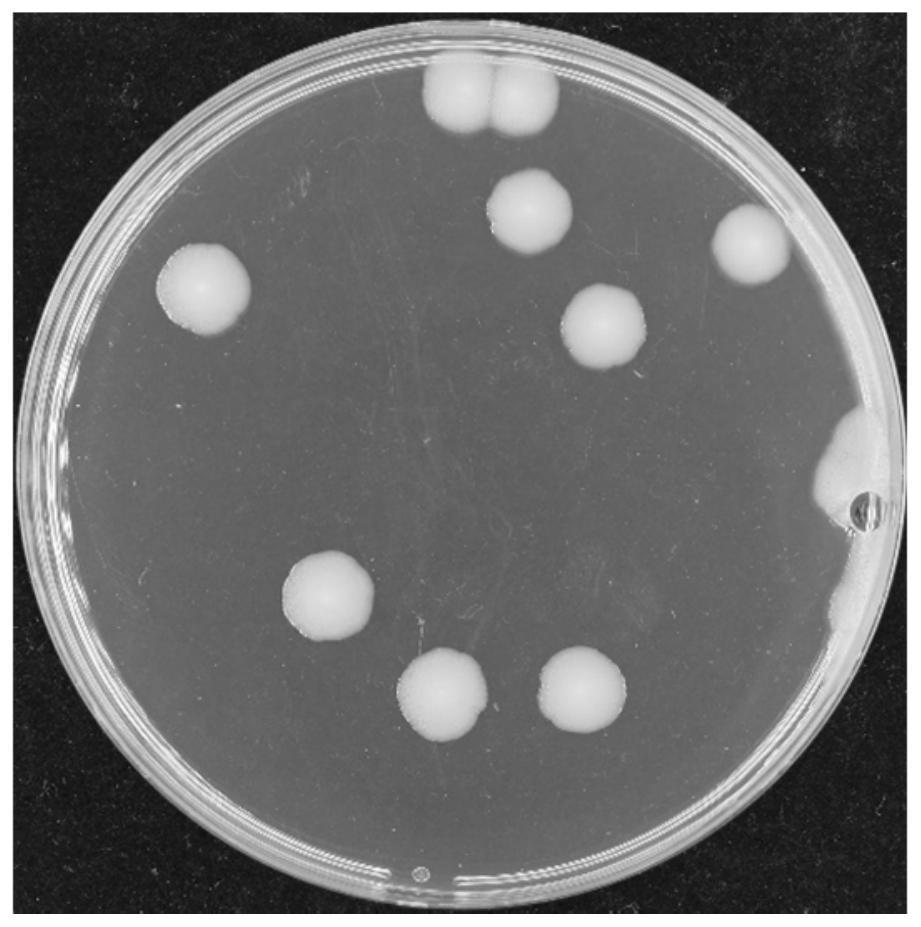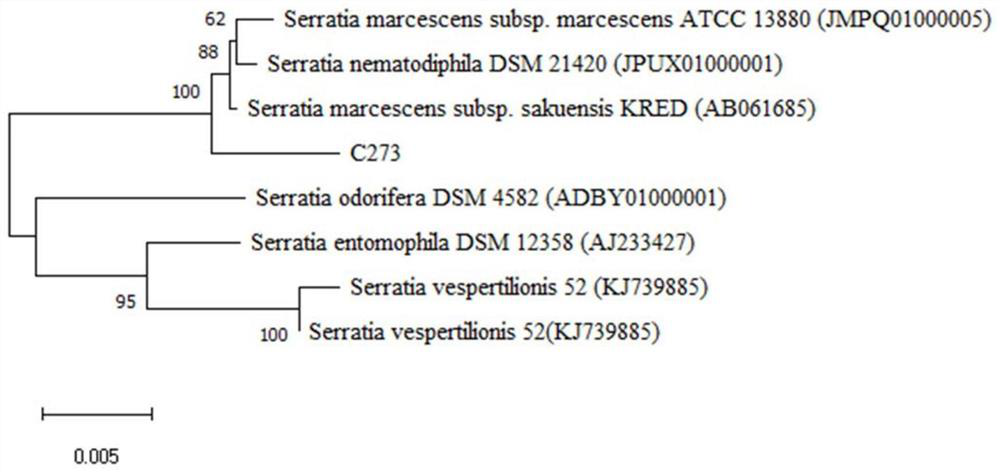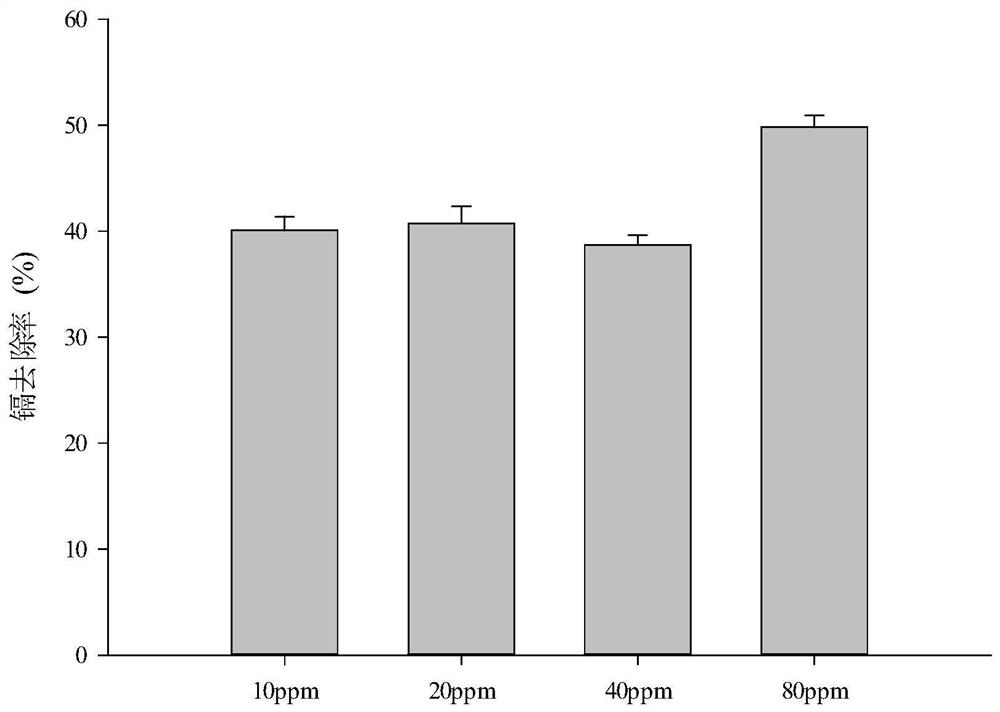A strain of Serratia marcescens and its application
A technology of Serratia marcescens and culture medium, which is applied in the field of microbial restoration of inorganic pollutants, can solve the problems of serious secondary pollution, high cost, long time consumption, etc., and achieves the effect of improving the content of available phosphorus in soil
- Summary
- Abstract
- Description
- Claims
- Application Information
AI Technical Summary
Problems solved by technology
Method used
Image
Examples
Embodiment 1
[0051] Screening, isolation and purification and identification of embodiment 1 bacterial strain C273
[0052] 1. Screening method of a cadmium-resistant and cadmium ion-removing bacterial strain C273
[0053] 1. Material preparation
[0054] Soil source for bacterial strain screening: The rhizosphere soil of paddy fields around Dabaoshan, Shaoguan City, Guangdong Province was collected. The soil samples were sealed with sampling bags, and brought back to the laboratory at 4°C for storage for later use.
[0055] LB medium: peptone 10.0g, yeast extract powder 5.0g, NaCl 10.0g, pH7.0-7.2, distilled water to 1L; solid medium plus 18.0g agar powder. Sterilize at 121°C for 15 minutes.
[0056] Inorganic salt medium (MSM medium): 5mL phosphate buffer solution (KH 2 PO 4 8.5g·L -1 、K 2 HPO 4 ·H 2 O2 1.75g·L -1 、Na 2 HPO 4 12H 2 O 33.4g·L -1 , NH 4 Cl 5.0g L -1 ), 3.0mL 22.5g·L -1 MgSO 4 Solution (MgSO 4 ·7H 2 O 46.125g·L -1 ), 1.0mL 0.25g·L -1 FeCl 3 Solution ...
Embodiment 2
[0079] Example 2 bacterial strain C273 contains Cd 2+ Cd in inorganic salt medium with peptone 2+ removal of
[0080] Streak the strain C273 on the LB plate and culture it at 30°C for 20 hours, pick a single colony and inoculate it in the LB liquid medium, culture it in a shaker at 30°C and 150 rpm for 20 hours, and then inoculate it at a ratio of 2% (v / v) to Cd 2+ Concentrations of 10, 20, 40 and 80mg·L -1 containing 10g·L -1 Tryptone was cultured in MSM medium, and samples were taken after 6 d (days); no addition of strain S1 was used as the control (CK), and three repeated experiments were set up. The sample liquid was centrifuged at 80,000 rpm for 10 min, and the supernatant was filtered with a 0.22 μm filter membrane, and the Cd was measured by flame atomic absorption spectrometry (AAS) after filtration. 2+ Residual amount (method is with embodiment 1).
[0081] Cd after 6 days of culture 2+ removal efficiency as image 3 Shown: The results show that after the add...
Embodiment 3
[0082] Phosphorus-dissolving and potassium-dissolving qualitative test of embodiment 3 bacterial strain C273
[0083] Phosphorus and potassium solubilization of bacterial strain C273 (phosphate / potassium solubilizing bacteria, meaning to convert insoluble phosphorus and potassium into soluble phosphorus and potassium) (specific references: Rawat, P., Das, S., Shankhdhar, D., et al., Phosphate-solubilizing microorganisms: Mechanism and their role in phosphate solubilization and uptake [J]. Journal of Soil Science and Plant Nutrition. 2020, https: / / doi.org / 10.1007 / s42729-020-00342-7.) Functional qualitative test: Inoculate the strain C273 drawn on LB solid medium into LB liquid medium, shake and culture at 125~150rpm, 28~30℃ for 18~24h, then Spot on PKO culture medium and potassium bacteria solid culture medium respectively, and inoculate 2% on PKO liquid culture medium and potassium bacteria liquid culture medium, establish 3 repeated experiments, place 30 ℃ incubator or shake...
PUM
 Login to View More
Login to View More Abstract
Description
Claims
Application Information
 Login to View More
Login to View More - R&D
- Intellectual Property
- Life Sciences
- Materials
- Tech Scout
- Unparalleled Data Quality
- Higher Quality Content
- 60% Fewer Hallucinations
Browse by: Latest US Patents, China's latest patents, Technical Efficacy Thesaurus, Application Domain, Technology Topic, Popular Technical Reports.
© 2025 PatSnap. All rights reserved.Legal|Privacy policy|Modern Slavery Act Transparency Statement|Sitemap|About US| Contact US: help@patsnap.com



